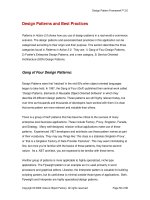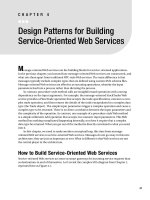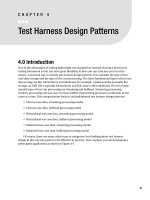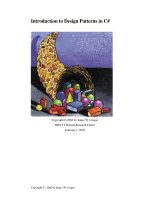Dive into design patterns Alexander Shvets
Bạn đang xem bản rút gọn của tài liệu. Xem và tải ngay bản đầy đủ của tài liệu tại đây (32.32 MB, 410 trang )
Divee Int
n to
DE
DESSIGN
PAT TERN
TERNSS
A Few Words on Copyright
Hi! My name is Alexander Shvets. I’m
the author of the book Dive Into
Design Patterns and the online course
Dive Into Refactoring.
This book is for your personal use only.
Please don’t share it with any third
parties except your family members. If you’d like to share the
book with a friend or colleague, buy and send them a
new copy.
All profit from the sale of my books and courses is spent on
the development of Refactoring.Guru. Each copy sold helps
the project immensely and brings the moment of a new book
release a little bit closer.
Alexander Shvets, Refactoring.Guru, 2019
Illustrations: Dmitry Zhart
Editing: Andrew Wetmore, Rhyan Solomon
I dedicate this book to my wife, Maria. If it
hadn’t been for her, I’d probably have finished
the book some 30 years later.
4
Table of Contents
Table of Contents
Table of Contents ....................................................................................... 4
How to Read This Book.............................................................................. 6
INTRODUCTION TO OOP ............................................................................. 7
Basics of OOP ................................................................................... 8
Pillars of OOP .................................................................................13
Relations Between Objects........................................................20
INTRODUCTION TO DESIGN PATTERNS.................................................23
What’s a Design Pattern? ............................................................24
Why Should I Learn Patterns?...................................................28
SOFTWARE DESIGN PRINCIPLES ...........................................................29
Features of Good Design ............................................................30
Design Principles.............................................................................34
§ Encapsulate What Varies ...............................................35
§ Program to an Interface, not an Implementation.39
§ Favor Composition Over Inheritance ........................44
SOLID Principles..............................................................................48
§ Single Responsibility Principle....................................49
§ Open/Closed Principle....................................................51
§ Liskov Substitution Principle .......................................54
§ Interface Segregation Principle...................................61
§ Dependency Inversion Principle .................................64
5
Table of Contents
CATALOG OF DESIGN PATTERNS............................................................68
Creational Design Patterns...........................................................69
§ Factory Method.................................................................71
§ Abstract Factory................................................................87
§ Builder............................................................................... 103
§ Prototype.......................................................................... 122
§ Singleton.......................................................................... 136
Structural Design Patterns........................................................ 146
§ Adapter ............................................................................. 149
§ Bridge ................................................................................ 162
§ Composite ........................................................................ 177
§ Decorator.......................................................................... 191
§ Facade ............................................................................... 209
§ Flyweight ......................................................................... 219
§ Proxy .................................................................................. 233
Behavioral Design Patterns ....................................................... 246
§ Chain of Responsibility ............................................... 250
§ Command ......................................................................... 268
§ Iterator .............................................................................. 289
§ Mediator ........................................................................... 304
§ Memento .......................................................................... 320
§ Observer ........................................................................... 336
§ State................................................................................... 352
§ Strategy ............................................................................ 368
§ Template Method .......................................................... 381
§ Visitor ................................................................................ 393
Conclusion .............................................................................................. 409
6
How to read this book
How to Read This Book
This book contains the descriptions of 22 classic design patterns formulated by the “Gang of Four” (or simply GoF) in 1994.
Each chapter explores a particular pattern. Therefore, you can
read from cover to cover or by picking the patterns you’re interested in.
Many patterns are related, so you can easily jump from topic
to topic using numerous anchors. The end of each chapter has
a list of links between the current pattern and others. If you
see the name of a pattern that you haven’t seen yet, just keep
reading—this item will appear in one of the next chapters.
Design patterns are universal. Therefore, all code samples in
this book are written in pseudocode that doesn’t constrain the
material to a particular programming language.
Prior to studying patterns, you can refresh your memory by
going over the key terms of object-oriented programming.
That chapter also explains the basics of UML diagrams, which
is useful because the book has tons of them. Of course, if you
already know all of that, you can proceed to learning patterns
right away.
INTRODUCTION
TO OOP
8
Introduction to OOP / Basics of OOP
Basics of OOP
Object-oriented programming is a paradigm based on the concept of wrapping pieces of data, and behavior related to that
data, into special bundles called objects, which are constructed from a set of “blueprints”, defined by a programmer, called
classes.
Objects, classes
Do you like cats? I hope you do because I’ll try to explain the
OOP concepts using various cat examples.
This is a UML class diagram. You’ll see a lot of such diagrams in the book.
9
Introduction to OOP / Basics of OOP
Say you have a cat named Oscar. Oscar is an object, an instance
of the Cat class. Every cat has a lot of standard attributes:
name, sex, age, weight, color, favorite food, etc. These are the
class’s fields.
All cats also behave similarly: they breathe, eat, run, sleep and
meow. These are the class’s methods. Collectively, fields and
methods can be referenced as the members of their class.
Data stored inside the object’s fields is often referenced
as state, and all the object’s methods define its behavior.
Objects are instances of classes.
10
Introduction to OOP / Basics of OOP
Luna, your friend’s cat, is also an instance of the Cat class.
It has the same set of attributes as Oscar. The difference is in
values of these attributes: her sex is female, she has a different color, and weighs less.
So a class is like a blueprint that defines the structure for
objects, which are concrete instances of that class.
Class hierarchies
Everything fine and dandy when we talk about one class. Naturally, a real program contains more than a single class. Some
of these classes might be organized into class hierarchies. Let’s
find out what that means.
Say your neighbor has a dog called Fido. It turns out, dogs
and cats have a lot in common: name, sex, age, and color are
attributes of both dogs and cats. Dogs can breathe, sleep and
run the same way cats do. So it seems that we can define the
base Animal class that would list the common attributes and
behaviors.
A parent class, like the one we’ve just defined, is called a
superclass. Its children are subclasses. Subclasses inherit state
and behavior from their parent, defining only attributes or
behaviors that differ. Thus, the Cat class would have the
meow method, and the Dog class the bark method.
11
Introduction to OOP / Basics of OOP
UML diagram of a class hierarchy. All classes in this diagram are part of
the Animal class hierarchy.
Assuming that we have a related business requirement, we can
go even further and extract a more general class for all living Organisms which will become a superclass for Animals
and Plants . Such a pyramid of classes is a hierarchy. In such
a hierarchy, the Cat class inherits everything from both the
Animal and Organism classes.
12
Introduction to OOP / Basics of OOP
Classes in a UML diagram can be simplified if it’s more important to show
their relations than their contents.
Subclasses can override the behavior of methods that they
inherit from parent classes. A subclass can either completely replace the default behavior or just enhance it with some
extra stuff.
13
Introduction to OOP / Pillars of OOP
Pillars of OOP
Object-oriented programming is based on four pillars, concepts that differentiate it from other programming paradigms.
Abstraction
Most of the time when you’re creating a program with OOP,
you shape objects of the program based on real-world objects.
However, objects of the program don’t represent the originals with 100% accuracy (and it’s rarely required that they do).
Instead, your objects only model attributes and behaviors of
real objects in a specific context, ignoring the rest.
For example, an Airplane class could probably exist in both
a flight simulator and a flight booking application. But in the
former case, it would hold details related to the actual flight,
whereas in the latter class you would care only about the seat
map and which seats are available.
14
Introduction to OOP / Pillars of OOP
Different models of the same real-world object.
Abstraction is a model of a real-world object or phenomenon,
limited to a specific context, which represents all details relevant to this context with high accuracy and omits all the rest.
Encapsulation
To start a car engine, you only need to turn a key or press a
button. You don’t need to connect wires under the hood, rotate
the crankshaft and cylinders, and initiate the power cycle of
the engine. These details are hidden under the hood of the
car. You have only a simple interface: a start switch, a steering
wheel and some pedals. This illustrates how each object has
an interface—a public part of an object, open to interactions
with other objects.
16
Introduction to OOP / Pillars of OOP
that any object passed to an airport object, whether it’s an
Airplane , a Helicopter or a freaking DomesticatedGryphon
would be able to arrive or depart from this type of airport.
UML diagram of several classes implementing an interface.
You could change the implementation of the fly method in
these classes in any way you want. As long as the signature
of the method remains the same as declared in the interface,
all instances of the Airport class can work with your flying
objects just fine.
17
Introduction to OOP / Pillars of OOP
Inheritance
Inheritance is the ability to build new classes on top of existing ones. The main benefit of inheritance is code reuse. If you
want to create a class that’s slightly different from an existing
one, there’s no need to duplicate code. Instead, you extend the
existing class and put the extra functionality into a resulting
subclass, which inherits fields and methods of the superclass.
The consequence of using inheritance is that subclasses have
the same interface as their parent class. You can’t hide a
method in a subclass if it was declared in the superclass. You
must also implement all abstract methods, even if they don’t
make sense for your subclass.
UML diagram of extending a single class versus implementing multiple
interfaces at the same time.
In most programming languages a subclass can extend only
one superclass. On the other hand, any class can implement
several interfaces at the same time. But, as I mentioned before,
18
Introduction to OOP / Pillars of OOP
if a superclass implements an interface, all of its subclasses
must also implement it.
Polymorphism
Let’s look at some animal examples. Most Animals can make
sounds. We can anticipate that all subclasses will need to override the base makeSound method so each subclass can emit
the correct sound; therefore we can declare it abstract right
away. This lets us omit any default implementation of the
method in the superclass, but force all subclasses to come up
with their own.
Imagine that we’ve put several cats and dogs into a large bag.
Then, with closed eyes, we take the animals one-by-one out of
19
Introduction to OOP / Pillars of OOP
the bag. After taking an animal from the bag, we don’t know
for sure what it is. However, if we cuddle it hard enough, the
animal will emit a specific sound of joy, depending on its concrete class.
1
bag = [new Cat(), new Dog()];
2
3
4
foreach (Animal a : bag)
a.makeSound()
5
6
// Meow!
7
// Woof!
The program doesn’t know the concrete type of the object contained inside the a variable; but, thanks to the special mechanism called polymorphism, the program can trace down the
subclass of the object whose method is being executed and
run the appropriate behavior.
Polymorphism is the ability of a program to detect the real class
of an object and call its implementation even when its real
type is unknown in the current context.
You can also think of polymorphism as the ability of an object
to “pretend” to be something else, usually a class it extends or
an interface it implements. In our example, the dogs and cats
in the bag were pretending to be generic animals.
20
Introduction to OOP / Relations Between Objects
Relations Between Objects
In addition to inheritance and implementation that we’ve
already seen, there are other types of relations between
objects that we haven’t talked about yet.
UML Association. Professor communicates with students.
Association is a type of relationship in which one object uses or
interacts with another. In UML diagrams the association relationship is shown by a simple arrow drawn from an object and
pointing to the object it uses. By the way, having a bi-directional association is a completely normal thing. In this case,
the arrow has a point at each end.
In general, you use an association to represent something like
a field in a class. The link is always there, in that you can
always ask an order for its customer. It need not actually be a
field, if you are modeling from a more interface perspective, it
can just indicate the presence of a method that will return the
order’s customer.
21
Introduction to OOP / Relations Between Objects
UML Dependency. Professor depends on salary.
Dependency is a weaker variant of association that usually
implies that there’s no permanent link between objects.
Dependency typically (but not always) implies that an object
accepts another object as a method parameter, instantiates, or
uses another object. Here’s how you can spot a dependency
between classes: a dependency exists between two classes if
changes to the definition of one class result in modifications
in another class.
UML Composition. University consists of departments.
Composition is a “whole-part” relationship between two
objects, one of which is composed of one or more instances of
the other. The distinction between this relation and others is
that the component can only exist as a part of the container.
In UML the composition relationship is shown by a line with
a filled diamond at the container end and an arrow at the end
pointing toward the component.
22
Introduction to OOP / Relations Between Objects
While we talk about relations between objects, keep in
mind that UML represents relations between classes. It
means that a university object might consist of multiple
departments even though you see just one “block” for
each entity in the diagram. UML notation can represent
quantities on both sides of relationships, but it’s okay to
omit them if the quantities are clear from the context.
UML Aggregation. Department contains professors.
Aggregation is a less strict variant of composition, where one
object merely contains a reference to another. The container doesn’t control the life cycle of the component. The component can exist without the container and can be linked to
several containers at the same time. In UML the aggregation
relationship is drawn the same as for composition, but with an
empty diamond at the arrow’s base.
INTRODUCTION
TO PATTERNS
24
Introduction to Design Patterns / What’s a Design Pattern?
What’s a Design Pattern?
Design patterns are typical solutions to commonly occurring
problems in software design. They are like pre-made blueprints that you can customize to solve a recurring design problem in your code.
You can’t just find a pattern and copy it into your program,
the way you can with off-the-shelf functions or libraries. The
pattern is not a specific piece of code, but a general concept
for solving a particular problem. You can follow the pattern
details and implement a solution that suits the realities of your
own program.
Patterns are often confused with algorithms, because both
concepts describe typical solutions to some known problems.
While an algorithm always defines a clear set of actions that
can achieve some goal, a pattern is a more high-level description of a solution. The code of the same pattern applied to two
different programs may be different.
An analogy to an algorithm is a cooking recipe: both have clear
steps to achieve a goal. On the other hand, a pattern is more
like a blueprint: you can see what the result and its features
are, but the exact order of implementation is up to you.









